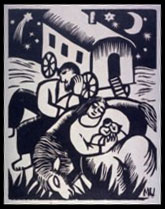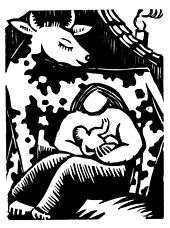Maria Uhden
Maria Uhden (born March 6, 1892 in Coburg , † August 14, 1918 in Munich ) was a German painter and graphic artist .
family
Maria Uhden comes from the old merchant, civil servant and pastor family Uhden , originally based in Gardelegen in the Altmark . In older sources are mentioned: 1393 Ciriacus and Henning Uden, 1419 the brothers Niclas and Ciriacus Uden and 1493 mayor Udo Udonis. In Egeln near Magdeburg the family is documented in 1552. The secured family line begins with Christian Röttger Heinrich Uhde , a merchant in Egeln, and Dorothea Rulmann , who was married there on June 6, 1608 .
Maria Uhden was the eldest daughter of the architect and Gothic builder Conrad Uhden (1856–1943) from the Sorge domain near Crossen on the Oder and Marie Forkel from Coburg (* 1868), daughter of the judiciary Emil Forkel and Henriette Frommann. Her siblings were:
- Werner Uhden (1893–1949), retired lieutenant. D., Dipl.-Ing.
- Hedwig Uhden (1895–1946), nurse
- Elisabeth Uhden (1897–1918)
- Erna Uhden (1898–1975)
She married Georg Schrimpf (1889–1938), professor and painter, son of the businessman Franz Xaver Schrimpf and Henriette Dorothea Schorre in her father's house in Gotha on May 15, 1917 . The couple's only child was their son Markus Schrimpf .
Childhood and school
Uhden grew up as the eldest of five siblings in the royal seat of Coburg with her parents in a middle-class family. The apartment was in Mohrenstrasse 13. The father had studied architecture in Dresden until 1885 and was registered as an architect and teacher in 1890. When Maria was 8 years old, the family moved to the town of Waltershausen , where the father had been transferred as a building inspector.
Because of the promotion of the father to the ducal building officer in the residential city of Gotha (in 1910) the family moved again. In the house at Waltershäuser Strasse 9, she moved into the second floor of a newly built three-story apartment building. Again Maria had to leave her friends behind and make new ones.
“That was a big change for us. To move from the idyllic small town to the big city ... During these years in Gotha, Mizi (Maria), our oldest sister ... was still at home. She was the brightest of us all, I think, and had an incredible imagination. We four sisters lived in the large room next to the stairs and were able to set up comfortably there. "
Uhden made friends with Hannah Höch (1889–1978), who was two years older than him and also came from a middle-class family. Like herself, Hannah was the eldest of five siblings and had a desire to study art - contrary to her father's idea that girls should marry. At the age of 18, in 1911, Maria went to Berlin, her friend Hannah followed in 1912. There both had contacts with the expressionist artist group "Der Sturm" and the magazine Der Sturm (magazine) which he published .
Life
From 1911 to 1913 Maria Uhden took private drawing lessons from the architect August Exter in Munich and at times attended the Berlin School of Applied Arts . In 1915 she met the influential publicist and gallery owner Herwarth Walden . From his critical advice she received more stylistic and technical suggestions than from her previous teachers. In the same year he exhibited her pictures in his “Sturm” in Berlin. He reproduced her works as postcards and sells hand-embroidered pillows by Maria Uhden in his gallery.
In 1915, the painter Georg Schrimpf saw her woodcuts and watercolors for the first time in the “Sturm” . He recalled in 1920: “I was delighted with it more than any other picture and said to myself: 'This is the best person, I believe in this one.'” They met a year later. They married on May 16, 1917. On June 22, 1918, she gave birth to their son Markus in Munich. She died as a result of childbirth.
In admiration for Franz Marc and Marc Chagall , whom she shared with her husband, the child was to be named Jean Marc, but the registrar insisted on Johannes Markus, since French first names were not wanted at this time of the war.
plant
The influence of Franz Marc and Marc Chagall is unmistakable in Maria Uhden's work. In her pictures she tells nocturnal stories of women, horses, bulls, pigs, and of people falling from the starry sky. In a letter to her husband in early 1917, she wrote: “I think it makes life so beautiful when you experience the essence of all things, because everything has its soul: flowers, animals, clouds, mountains, cities, houses, the stupidest things, a stone, a brush, a piece of paper, everything! ”This attitude to life has determined her entire work and is expressed in it. This is how the writer Oskar Maria Graf described the effect of her painting on the viewer: "An immense gentleness and earthly gravity flows from the bodies of humans and animals."
Maria Uhden initially worked in small formats: watercolors, gouaches , woodcuts. It was only later that she switched to large-format oil paintings . Much of her painterly work is believed to have been lost.
|
|
|
Honors
- In 2000 a street in Gotha was named Maria-Uhden-Weg .
Individual evidence
- ↑ German Gender Book , Volume 128, Page 354.
- ↑ so her younger sister Elisabeth Uhden after Mathias Wenzel: artist escaped small-town milieu. In: Thüringische Landeszeitung (TLZ), ZA GO4, Gotha district, from March 1, 2003
- ↑ Cara Schweitzer: Unlimited freedom for Hannah Höch . Biography. 2nd edition, Hamburg 2014, p. 20. ISBN 978-3-940731-64-7 .
literature
- Oskar Maria Graf : Maria Uhden. Klinkhardt & Biermann, Leipzig 1921. (= Young Art , Volume 20.)
- Wolfgang Storch: Georg Schrimpf and Maria Uhden. Life and work. Charlottenpresse, Berlin 1985, ISBN 3-88725-189-X . (with a catalog raisonné by Karl-Ludwig Hofmann and Christmut Praeger)
- Hans Julius Duncker : Uhde sex. Starke, 1940 (contents of the first delivery: prehistory of Uhdes, the collection of documents on Uhde history and the descendants of lines 1–3, print proof)
- Gustav Uhde: Gender register of the Uden or Uhden. Robert Lucas, Breslau 1855.
- Mannheimer Kunstverein, Karl-Ludwig Hofmann, Christmut Präger (eds.): Maria Uhden (1892–1918). Letters, certificates and lists of the works left behind. (Catalog for the exhibition in the Mannheimer Kunstverein and in the Gerhard Marcks Foundation Bremen in the summer of 1994) Brinkmann & Bose, Berlin 1994, ISBN 3-922660-62-2 .
- Ingrid Pfeiffer, Max Hollein (Hrsg.): Sturm-Frauen: Artists of the avant-garde in Berlin 1910-1932 . Wienand, Cologne 2015, ISBN 978-3-86832-277-4 (catalog of the exhibition of the same name, Schirn Kunsthalle Frankfurt , October 30, 2015 to February 7, 2016).
Web links
- Literature by and about Maria Uhden in the catalog of the German National Library
| personal data | |
|---|---|
| SURNAME | Uhden, Maria |
| BRIEF DESCRIPTION | German painter and graphic artist |
| DATE OF BIRTH | March 6, 1892 |
| PLACE OF BIRTH | Coburg |
| DATE OF DEATH | August 14, 1918 |
| Place of death | Munich |


